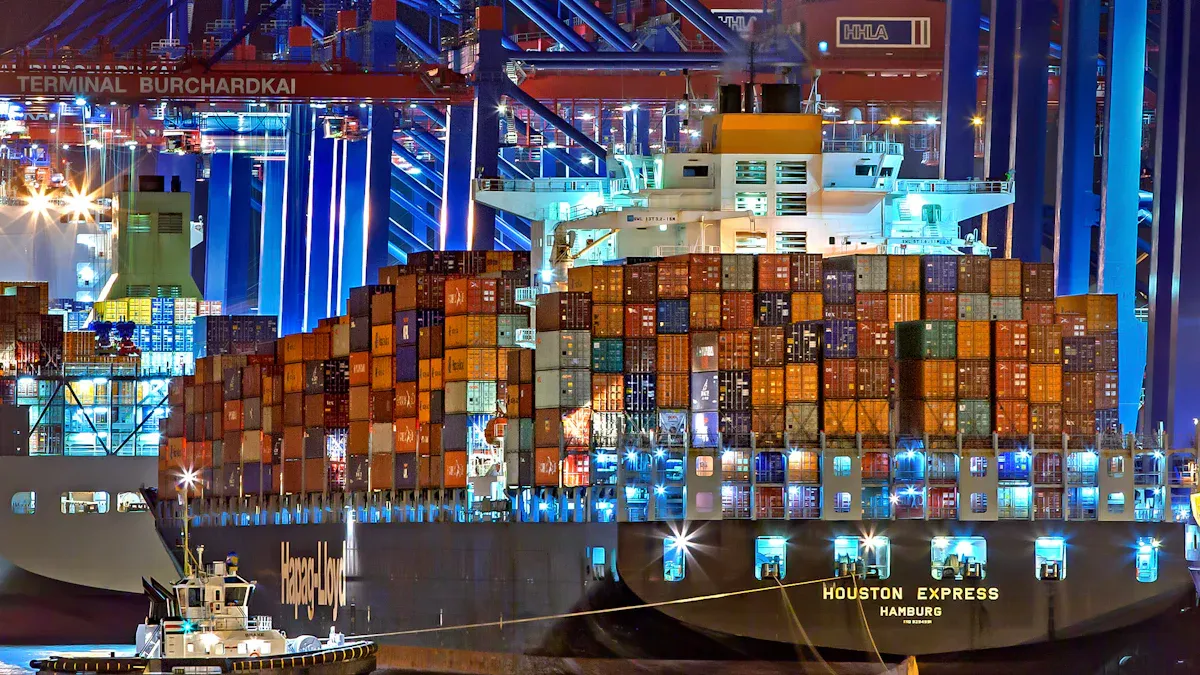How Tariff Policies Are Reshaping Global Markets in 2025

Tariff rules are now a big factor in global trade. They impact businesses, shoppers, and the world economy in major ways. Low-income families might lose up to $28,500. Wealthier families could lose even more money. About 76% of buyers plan to change how they shop because prices are going up. Over time, tariffs might change where goods come from. This could affect product quality and trade patterns. These shifts raise important questions about how tariffs shape markets and people everywhere.
Key Takeaways
Changes in tariffs greatly affect world trade, prices, and shopping habits. Families might pay more, losing up to $2,000 each year because of higher tariffs.
Companies need to adjust by finding new suppliers and improving delivery systems. This helps them avoid problems and stay strong in a changing market.
Trade deals between nearby countries are becoming more important. These deals help reduce tariff problems and support economic growth.
Latest Tariff Developments and Their Impact on Global Trade

Key Tariff Policy Changes in Major Economies
In recent years, big tariff changes have happened worldwide. In April 2025, the U.S. added a 10% tariff on most imports. This was a big jump from its 2024 rate of 3.3%. A 145% tariff was also placed on goods from China. This showed a tougher approach in the trade war. Experts think the U.S. average tariff will rise by 5%. This will make a bigger impact on global markets.
Other countries have also made changes. China raised tariffs on U.S. farm goods. The EU added higher taxes on American tech products. These moves show a rise in protectionism. Countries are now focusing more on their own industries. This makes it harder for businesses to deal with these changes.
Immediate Effects on Trade and Supply Chains
New tariffs have quickly caused problems for trade and supply chains. Higher tariffs mean higher costs for companies using foreign materials. For example, in 2024, the U.S. imported $3.25 trillion in goods. About $1.3 trillion came from countries like China, Mexico, and Canada. Manufacturing imports from these nations were $1.1 trillion, or 86% of the total. These numbers show how connected global trade is and how tariffs disrupt it.
Supply chains are facing big challenges. Companies are switching suppliers, which costs more money. This causes delays as they change their processes. Ports are getting crowded, and shipping routes are stressed. Businesses are also stocking up on goods to avoid future tariff hikes.
The trade war has made things worse. Higher tariffs hurt supplier relationships, forcing companies to find new ones. This creates risks for steady supply, especially when key suppliers are hit. These problems affect not just companies but entire industries and economies.
Emerging Trends in Tariff Implementation
New trends in tariffs show more focused and strategic policies. Governments now use tariffs to meet bigger goals. For example, the U.S. raised tariffs on Chinese tech to rely less on China. This also encourages more innovation at home. China, in turn, targeted U.S. farm goods to pressure farmers and trade talks.
Regional trade deals are also becoming more common. Southeast Asian countries are working together through deals like RCEP. These agreements lower tariffs between members and reduce trade war effects.
Technology is also changing how tariffs work. Digital tools help governments set specific tariffs on certain goods. This limits harm to other industries while meeting goals. But it also makes global trade more complicated. Businesses must stay alert and ready for changes.
Economic Impact of Tariffs on Global Markets
Trade Disruptions and Market Volatility
Changes in tariffs have upset global trade systems. These changes often cause markets to become unstable. Businesses and investors react quickly to new trade rules. For instance, the U.S. announced new tariffs in April 2025. This caused stock markets to drop sharply. Industries like cars and airlines faced higher costs and job cuts. During the 2018-2019 U.S.-China trade war, the S&P 500 fell by 5% on key tariff days. These examples show how trade issues can worry investors and lower demand.
Tariffs raise prices and slow down economic activity. They also create doubts, making companies delay investments. A 10% rise in U.S. tariffs could shrink U.S. GDP by 1% and global GDP by 0.5% by 2026. J.P. Morgan Research lowered its 2025 GDP growth estimate by 0.3% due to trade worries. These problems hurt global markets and make them less efficient.
Event | Market Reaction | Impact |
|---|---|---|
April 2025 Tariff Announcement | Stock markets dropped sharply | Higher costs and job losses |
2018-2019 US-China Trade War | S&P 500 fell by 5% on key days | Investors worried about trade disruptions |
Sector-Specific Impacts: Technology, Manufacturing, and Agriculture
Tariffs affect industries in different ways. Manufacturing faces big problems. For example, 93% of car and parts exports depend on the U.S. market. Also, 82% of nuclear machinery and 91% of plastics exports rely on U.S. buyers. Higher tariffs raise costs and hurt competitiveness. The energy sector is also at risk. About 90% of crude oil exports go to the U.S., making it vulnerable.
In farming, the average global tariff is 10%. Removing these tariffs could grow global trade by 11%. This would improve consumer welfare by $56.3 billion. But retaliatory tariffs, like Canada’s $155 billion on U.S. goods in 2023, caused inflation. Food prices in Canada went up, hurting both buyers and farmers.
Manufacturing: Relies on exports, making it sensitive to tariff changes.
Agriculture: Retaliatory tariffs raise food costs and hurt trade.
Energy: Crude oil exports are risky due to U.S. dependence.
Implications for Consumers and Inflation
Tariffs directly raise prices for consumers. Higher tariffs on imports increase costs for local companies. These costs are passed to buyers, raising the price index. For example, tariffs could raise prices by 0.6% and cost families $1,000 to $2,000 yearly. Long-term inflation reduces buying power and slows spending.
Industries using imported materials lose competitiveness and may cut jobs. Trade policy doubts also shake stock markets as investors fear disruptions. Economic growth could slow by 0.5% to 0.75%. These effects show how tariff policies impact the economy.
Impact Description | Estimated Value |
|---|---|
Slower economic growth | 0.5% to 0.75% |
Rise in consumer prices | 0.6% |
Cost per household | $1,000 to $2,000 |
Tariffs help local producers but hurt consumers. Higher prices and less buying power create long-term economic problems.
Geopolitical Shifts Driven by Tariff Policies

Changing Global Trade Alliances
Tariff changes are changing how countries trade with each other. Nations now prefer trading with allies who share their values. Trade between friendly nations has grown, while trade with rivals has dropped. For example, the U.S. added tariffs on Chinese goods to limit China's power. By 2024, U.S. tariffs on Chinese imports averaged 11.1%. This shows a plan to depend less on China. Events like Russia's attack on Ukraine have also hurt trade. Countries now focus on building stronger ties with trusted partners.
Regional trade deals are becoming more popular. Southeast Asian countries joined the Regional Comprehensive Economic Partnership (RCEP). This deal lowers tariffs between members and improves cooperation. These agreements help reduce global trade problems and create steadier markets.
The Role of Major Economies: US, China, and the EU
Big economies have different ways of handling trade policies. The U.S. wants to protect its industries and rely less on imports. Its tariffs on Chinese goods aim to boost local innovation. China uses tariffs to target U.S. farm exports and push trade talks. The EU takes a balanced approach. It adds tariffs on U.S. tech but supports free trade within Europe.
Each economy has its own goals. The U.S. focuses on safety and growth at home. China works to grow its influence worldwide. The EU tries to balance protectionism with global trade deals to stay competitive.
Impact on Developing Economies and Regional Trade Agreements
Poorer countries face big problems from higher tariffs. Tariffs make their goods more expensive and less competitive. Many depend on trade with big economies like the U.S. and China. When tariffs rise, these nations lose jobs and slow down economically. For example, African countries selling farm goods to the U.S. face higher costs, making trade harder.
Regional trade deals help ease these problems. Agreements like the African Continental Free Trade Area (AfCFTA) lower tariffs within Africa. This boosts trade between African countries and reduces dependence on bigger powers. These deals help poorer nations grow and work together despite global trade issues.
Business Strategies to Handle Tariff Problems
Using JUSDA’s Supply Chain Tools
Companies can use JUSDA’s tools to handle tariff problems. Their platform helps track shipments, predict demand, and manage inventory. These tools help businesses adjust to new trade rules and lower risks. For example, JUSDA makes it easier to move goods smoothly, even with tariff issues.
One example shows a tech company saving money by making products locally. This cut their need for imports and let them sell as "Made in the USA." Customers liked this change. With JUSDA’s help, businesses can stay strong in tough markets.
Improving Logistics with China-Europe Express Rail
The China-Europe Express Rail is a cheaper, faster shipping option. It takes 15-20 days, quicker than sea and cheaper than air. Customs are also easier, so delays are fewer.
The rail service boosted logistics by 4.55% on average.
Cities in central China gained the most from this service.
Areas making high-value goods saw big improvements.
Using this rail service helps companies save money and deal with tariff costs.
Spreading Risks with Diversification
Diversifying is a smart way to handle tariff risks. Companies can use many suppliers instead of relying on one. This lowers risks and opens chances in new markets.
Financial diversification helps investors earn more in risky times.
Tariffs raise costs, hurting profits and stopping some investments.
Diverse supply chains create chances in areas with fewer tariffs.
By diversifying, companies can stay steady in a changing global market.

JUSDA Solutions
To provide you with professional solutions and quotations.
Tariff rules in 2025 have changed the world economy. They affect trade problems, rising prices, and how people shop. Economic plans, global politics, and business changes are all linked. This shows how complex the world economy is now. As U.S. tariffs change, companies must find new ways to trade. Future rules will shape growth and affect world trade.
See Also
Exploring How Global Trade Policies Shape Economic Landscapes
Five Key Trends Enhancing Future Supply Chain Efficiency
Transforming Industries Through Innovative Cloud Supply Chain Solutions
Addressing Global Supply Chain Expansion Challenges Effectively
Achieving Supply Chain Success: Five Steps Using Market Trends
